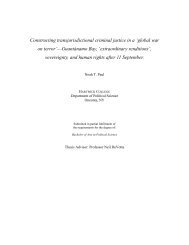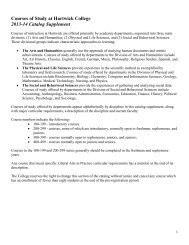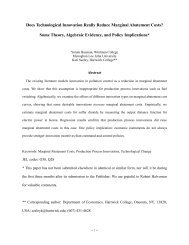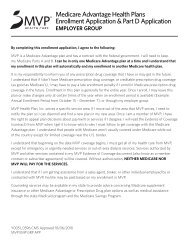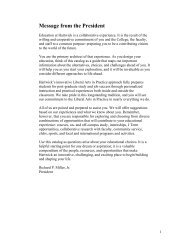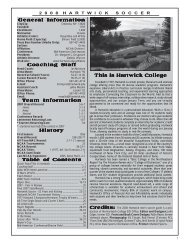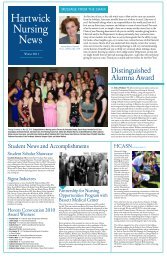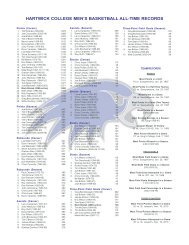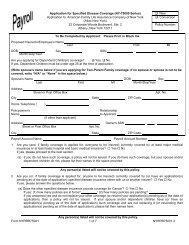Table of Contents - Hartwick College
Table of Contents - Hartwick College
Table of Contents - Hartwick College
Create successful ePaper yourself
Turn your PDF publications into a flip-book with our unique Google optimized e-Paper software.
It also may be pr<strong>of</strong>itably taken by upperclass students with an interest in<br />
the area. Competence in high school algebra is required. (LAB)<br />
163 General Astronomy (3 credits), (3 one-hour lectures weekly) An<br />
introduction to astronomy and astrophysics primarily for students whose<br />
major is in the Division <strong>of</strong> Physical and Life Sciences. Topics include<br />
methods <strong>of</strong> astronomy, stellar evolution, galactic structures and<br />
cosmology. Some observing sessions will be required. Competence in high<br />
school algebra is required. Credit can be awarded for only one <strong>of</strong> the<br />
following courses: Phys 121, Phys 163.<br />
201 General Physics I (4 credits), (3 one-hour lectures, 1 three-hour<br />
lab weekly) Topics in the first term include the description <strong>of</strong> motion,<br />
forces, work and energy, momentum, rotational motion, oscillatory<br />
motion and gravitation. Laboratory work is an important component <strong>of</strong><br />
the course. Calculus is used. This course (plus Phys 202) fulfill the physics<br />
requirements for biology, biochemistry, chemistry, geology, mathematics<br />
(Phys 201 only) and medical technology majors. Prerequisite: Math 121<br />
must be taken previous to or concurrent with Phys 201. (LAB)<br />
202 General Physics II (4 credits), (3 one-hour lectures, 1 three-hour<br />
lab weekly) A continuation <strong>of</strong> Phys 201. In this course, electricity,<br />
magnetism, light and electromagnetic radiation are covered. Laboratory<br />
work is an important component <strong>of</strong> the course. Calculus is used. This<br />
course (plus Phys 201) fulfill the physics requirements for biology,<br />
biochemistry, chemistry, geology, and medical technology majors.<br />
Prerequisite: a grade <strong>of</strong> C- or better in Phys 201. Math 235 must be taken<br />
previous to or concurrent with Phys 202. (LAB)<br />
265 Electronics (4 credits), (3 one-hour lectures, 1 three-hour lab<br />
weekly) An introduction to modern electronics. Topics include circuits,<br />
amplifiers, signal processing, practical instrumentation and logic circuits.<br />
Both discrete components and integrated circuits are discussed and used<br />
in laboratory experiments illustrating digital and analog applications.<br />
Prerequisite: Math 121 and Phys 140 or 201. Offered alternate years.<br />
(LAB)<br />
305 Atomic and Nuclear Physics (4 credits), (3 one-hour lectures, 1<br />
three-hour lab weekly) Introductory modern physics and quantum theory.<br />
Some <strong>of</strong> the topics studied are Compton scattering, the hydrogen tom, an<br />
introduction to Schroedinger quantum mechanics, nuclear structure, and<br />
elementary particles. Laboratory work includes measurement <strong>of</strong> atomic<br />
and nuclear particles, the Franck-Hertz experiment, spectroscopy, and<br />
computer simulation <strong>of</strong> an accelerator. Prerequisites: Phys 201, 202.<br />
Offered alternate years. (LAB)<br />
314 Thermodynamics and Statistical Physics (4 credits), (3 onehour<br />
lectures, 1 three-hour lab weekly) A study <strong>of</strong> relationships between<br />
thermodynamic variables and the statistical interpretation <strong>of</strong> these<br />
relationships. Topics studied include definition <strong>of</strong> temperature; the first<br />
and second laws <strong>of</strong> thermodynamics; entropy; properties <strong>of</strong> ideal gases<br />
and real substances; and statistical descriptions <strong>of</strong> systems <strong>of</strong> particles,<br />
including quantum statistics. Laboratory experiments emphasize the<br />
methods <strong>of</strong> measuring various thermodynamic variables. Prerequisites:<br />
Phys 201, 202. Offered alternate years. (LAB)<br />
318 Optics (4 credits), (3 one-hour lectures, 1 three-hour lab weekly) A<br />
study <strong>of</strong> geometrical and physical optics. Topics studied in class and<br />
201



